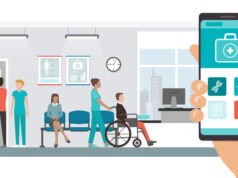ex. 1243
In order to minimize exposure to COVID-19, healthcare facilities need to separate healthy and suspected, uninfected patients from confirmed, infected patients. Hospital networks with multiple buildings in the community can dedicate the specific task of diagnosing or treating patients to separate locations.
The ideal process would leverage virtual visits to evaluate symptoms, reducing the risk of overburdening facilities or contaminating others. After a digital consult, patients would be referred to a drive-up testing location or an outpatient testing facility.
Outpatient facilities can transform into large-scale testing centers by applying the following design concepts:
- Enhance patient throughput with one-directional flow to prevent further contamination, with a dedicated entrance and exit. For urban environments, dedicated elevators can be utilized for entering and exiting patients.
- Utilize groups of exam rooms with architectural barriers to prevent spreading the infection.
- An on-stage/off-stage layout with separate corridors for clinical staff and patients provides additional protection for staff.
- Non-clinical workplaces can be repurposed for quarantining large groups with minimal symptoms.
- Mechanically, additional isolation or negative pressure rooms are beneficial for infection control. Ideally, it would be beneficial to enable all patient spaces to become negative pressure.
Once a diagnosis is received, patients would either be sent home to recover while being quarantined or to another facility for additional care.
Ambulatory surgery centers are an ideal environment for treating patients with mild symptoms. With patient holding bays for prep/recovery, multiple patients can be treated at once without concern of infecting others as all these patients will be assumed to be infected.
By directing all other patients away from the hospital, the hospital can focus on the most severe patients as it is the best setting for treating this patient population.
Seth Rothman, AIA, LEED AP BD+C, is a senior healthcare architect at E4H Environments for Health Architecture (New York). He can be reached at srothman@e4harchitecture.com.








